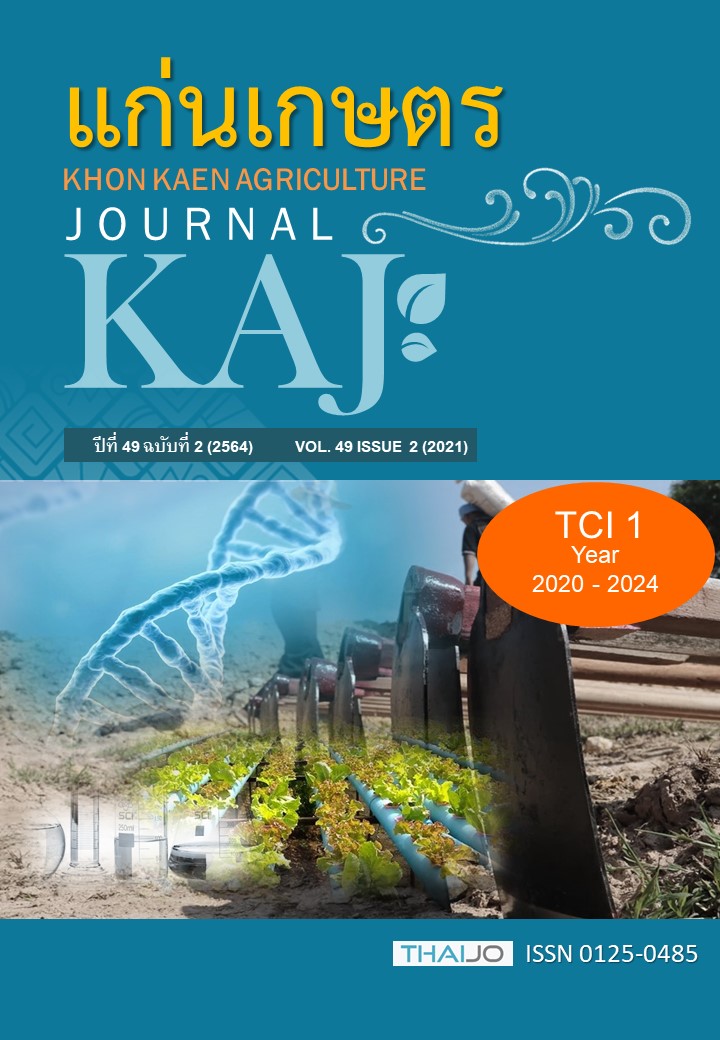การถ่ายทอดลักษณะทางพันธุกรรมความต้านทานโรคไวรัสใบหงิกเหลืองพริกในพริกเผ็ด
Main Article Content
บทคัดย่อ
ข้อมูลความสามารถในการถ่ายทอดลักษณะทางพันธุกรรมต้านทานต่อโรคไวรัสใบหงิกเหลืองพริก (Pepper yellow leaf curl virus, PepYLCV) มีความสำคัญต่อการพัฒนาพันธุ์ที่ต้านทานต่อโรคนี้ การศึกษานี้มีจุดมุ่งหมายเพื่อศึกษาความสามารถในการถ่ายทอดลักษณะทางพันธุกรรมความต้านทานต่อเชื้อ PepYLCV ในประชากรพริก 2 คู่ผสม (101/203 และ 103/203) ที่มาจากแหล่งความต้านทานแตกต่างกัน คือ Tiwari (101) และ PSP-11 (102) ผสมกับพันธุ์พริกที่มีลักษณะที่ดีทางการเกษตรแต่อ่อนแอต่อ PepYLCV (YTP18; 203) โดยสร้างประชากร 6 ประชากร ได้แก่ P1, P2, F1, F2, BC1P1 และ BC1P2 ปลูกทดสอบ 2 ฤดู ผลการวิเคราะห์ค่าเฉลี่ย ในคู่ผสม 101/203 พบอิทธิพลของยีนที่ควบคุมความต้านทานเป็นแบบบวกสะสม x แบบข่ม มี h2n ต่ำทั้ง 2 ฤดู และควบคุมด้วยยีนหลายคู่ อิทธิพลของยีนควบคุมผลผลิตเป็นแบบ บวกสะสม x บวกสะสม มี h2n ต่ำทั้ง 2 ฤดู และอิทธิพลของยีนควบคุมลักษณะปริมาณสารแคปไซซินอยด์เป็นแบบข่ม x แบบข่ม ในฤดูแล้ง มี h2n สูงในฤดูแล้ง ส่วนในพริกคู่ผสม 103/203 พบอิทธิพลของยีนต้านทานเป็นแบบบวกสะสม x บวกสะสม และมี h2n ต่ำทั้ง 2 ฤดู และควบคุมด้วยยีนหลักที่เป็นยีนเด่น 1 คู่ อิทธิพลของยีนผลผลิตเป็นแบบข่ม x แบบข่ม มี h2n สูงทั้ง 2 ฤดู และอิทธิพลควบคุมลักษณะสารแคปไซซินอยด์เป็นแบบข่ม x แบบข่ม ในฤดูแล้ง และมี h2n สูงในฤดูฝน เนื่องจากลักษณะผลผลิตและสารแคปไซซินอยด์ควบคุมด้วยยีนหลายคู่ ดังนั้นในการพัฒนาพันธุ์พริกให้ต้านทานต่อ PepYLCV และมีลักษณะทางการเกษตรที่ดีจึงควรใช้วิธีคัดเลือกแบบบันทึกประวัติ และผสมกลับ
Article Details

อนุญาตภายใต้เงื่อนไข Creative Commons Attribution-NonCommercial-NoDerivatives 4.0 International License.
เอกสารอ้างอิง
นครินทร์ จี้อาทิตย์ ธัญญารัตน์ ตาอินต๊ะ ญาณิศา แสงสอดแก้ว พัชราภรณ์ สุวอ Sanjeet Kumar, Wen-Shi Tsai และสุชีลา เตชะวงค์เสถียร. 2016. การประเมินความต้านทานโรคใบหงิกเหลืองของพริก (Capsicum spp.). วารสารพืชศาสตร์สงขลานครินทร์. 3: 26-31.
วิภาลัย พุตจันทึก. 2555. ผลของชนิดพืชอาหารต่อชีววิทยาของแมลงหวี่ขาวยาสูบ Bemisia tabaci และประสิทธิภาพของด้วงเต่าตัวห้ำ Serangium sp. และแตนเบียน Encarsia sophia. วิทยานิพนธ์ปริญญาวิทยาศาสตรมหาบัณฑิตมหาวิทยาลัยขอนแก่น, ขอนแก่น.
วิลาวัณย์ ใคร่ครวญ รักชัย คุรุบรรเจิดจิต ศัลยมล นิเทศพัฒนพงษ์ และอำไพ ประเสริฐสุข. 2558. การปรับปรุงพันธุ์เพื่อเพิ่มมูลค่าผลผลิตพริก. รายงานชุดโครงการวิจัยและพัฒนาพริก. กรมวิชาการเกษตร.
สุชีลา เตชะวงค์เสถียร. 2557. พริก: นวัตกรรมจากทฤษฎีการปรับปรุงพันธุ์พืชสู่การใช้ประโยชน์. โรงพิมพ์คลังนานาวิทยา. ขอนแก่น.
สิทธิวุฒ เมธาสิริปกรณ์ สมพงศ์ จันทร์แก้ว เพชรรัตน์ ธรรมเบญจพล และ จิรวัฒน์ สนิทชน. 2560. การวิเคราะห์ค่าเฉลี่ยระหว่างชั่วของลักษณะความต้านทานต่อโรคขอบใบแห้งในข้าวพื้นเมืองพันธุ์ผาลาดำ. แก่นเกษตร. 45: 7-14.
Chomdej, O., U. Pongpayaklers, and J. Chunwongse. 2012. Resistance to tomato yellow leaf curl virus- Thailand isolate (TYLCTHV-[2]) and markers loci association in BC 2 F 1 population from a cross between Seedathip 3 and a wild tomato, Solanum habrochaites' L06112'clone no. 1. Songklanakarin Journal of Science & Technology. 34: 31-36.
Collins, M., and K. J. Moore. 1995. Postharvest processing of forages. The Science of Grassland Agriculture. 2: 147–161.
Ganefianti, D. W., S. Sujiprihati, S. H. Hidayat, and D. M. Syuku. 2008. Infection methods and resistance of pepper genotypes to Begomovirus. Journal Akta Agrosia. 2: 162-169.
Ganefianti, D. W., S. H. Hidayat, and M. Syukur. 2015. Genetic study of resistance to Begomovirus on Chili pepper by Hayman's diallel analysis. International Journal on Advanced Science, Engineering and Information Technology. 5: 426-432.
Jindal, S.K., M. S. Dhaliwal, A. Sharma, and H. Thakur. 2018. Inheritance studies for resistance to leaf curlvirus disease in chilli (Capsicum annuum L.). Agricultural Research Journal. 55: 757-760.
Kumar, S., R. Kumar, S. Kumar, M. Singh, A. B. Rai, and M. Rai. 2009. Reaction of pepper leaf curl virus field resistance of chilli (Capsicum annuum L.) genotypes under challenged condition. Vegetable Science. 36: 230-232.
Mather, K., and J. L. Jinks. 1971. Components of means: additive and dominance effects. In Biometrical Genetics (pp. 65-82). Springer, Boston, MA.
Mather, B. S. K., and J. L. Jinks. 1982. Biometrical genetics. Ed ke-3. New York: Chapman and Hall. 396 hal.
Murthy, H. M. K., and A. A. Deshpande. 1997. Genetics of yield attributes in chilli (Capsicum annuum L.). Vegetable Science. 24: 118-122.
Nyquist, W. E., and R. J. Baker. 1991. Estimation of heritability and prediction of selection response in plant populations. Critical reviews in plant sciences. 10: 235-322.
Prakash, S., and S. J. Singh. 2006. Insect transmitted virus of pepper: Vegetation Science. 33: 109-116.
Rai, V. P., R. Kumar, S. P. Singh, S. Kumar, M. Singh, and M. Rai. 2014. Monogenic recessive resistance to Pepper leaf curl virus in an interspecific cross of Capsicum. Scientia Horticulturae. 172: 34-38.
Rubinstein, G., and H. Czosnek. 1997. Long-term association of tomato yellow leaf curl virus with its whitefly vector Bemisia tabaci: effect on the insect transmission capacity, longevity and fecundity. Journal of General Virology. 78: 2683-2689.
Singh, R. K., N. Rai, M. Singh, S. Saha, and S. N. Singh. 2015. Detection of tomato leaf curl virus resistance and inheritance in tomato (Solanum lycopersicum L.). The Journal of Agricultural Science. 153: 78.
Tempeetikul, V., S. Techawongstien., K. Lertrat, and S. Techawongstien. 2013. Inheritance of pungency in Thai hot pepper (Capsicum annuum L.). SABRAO Journal of Breeding & Genetics. 45: 248-254.
Zewdie, Y., and P.W. Bosland. 2000. Capsaiciniods inheritance in an interspecific hybridization of Capsicum annuum x Capsicum. chinense, Journal American Society Science. 125: 448-453.


